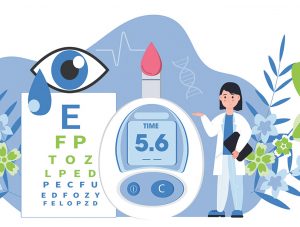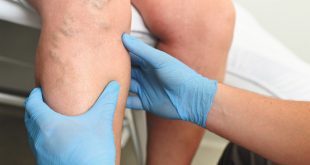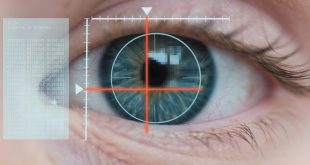 November is Diabetic Eye Disease Awareness Month, which is dedicated to focusing on the eye diseases related to diabetes and preventing related vision loss. People with type 1, type 2 or pregnancy-related diabetes are more susceptible to certain sight-stealing eye diseases, making regular comprehensive eye exams especially important so that an early diagnosis and appropriate treatment can help stop or delay disease progress. Diabetic people who aren’t sufficiently informed are twice as likely to develop certain eye diseases as those who are well-informed, making awareness crucial to optimal eye health.
November is Diabetic Eye Disease Awareness Month, which is dedicated to focusing on the eye diseases related to diabetes and preventing related vision loss. People with type 1, type 2 or pregnancy-related diabetes are more susceptible to certain sight-stealing eye diseases, making regular comprehensive eye exams especially important so that an early diagnosis and appropriate treatment can help stop or delay disease progress. Diabetic people who aren’t sufficiently informed are twice as likely to develop certain eye diseases as those who are well-informed, making awareness crucial to optimal eye health.
This article is a good starting point, so you’re already on your way to better vision protection.
Diabetic Eye Diseases
Roughly one in ten people in the US has a form of diabetes, and nearly one-third are prediabetic. These are concerning numbers. To protect the many millions of people who may be affected, the American Academy of Ophthalmology urges folks to take action now to protect their vision.
The most common eye diseases impacted by diabetics are the following:
Diabetic Retinopathy – The leading cause of blindness among diabetics, diabetic retinopathy occurs when high blood sugar levels damage blood vessels within the retina, which can result in severe vision loss, even blindness.
Types of diabetic retinopathy:
. Non-proliferative diabetic retinopathy (NPDR) – With NPDR, retinal blood vessels swell within the macula, damaging central vision and distorting details, dimming light and muting colors.
Typically symptomless in the beginning, untreated NPDR can develop into the second, more severe form:
. Proliferative diabetic retinopathy (PDR) – In this more advanced form, weak, abnormal blood vessels may develop and bleed within the eye, damaging central and peripheral vision, and sometimes progressing to complete blindness.
Macular Edema – Close to half of people who develop diabetic retinopathy also face diabetic macular edema (DME), a condition caused by excess fluid build-up, which creates swelling or buckling of the macula, and warps central vision.
The good news is that, with early diagnosis and treatment, diabetic retinopathy can be effectively managed and vision significantly protected from these threats.
Glaucoma – For people with diabetes, there is a significantly higher risk of a type of glaucoma called neovascular glaucoma, in which pressure damages the optic nerve, leading to vision loss. Like many eye diseases, glaucoma often produces no symptoms until permanent damage is done, so getting regular comprehensive eye exams promotes effective management to protect vision.
Cataracts – A cataract is a build-up of proteins that causes the lens of the eye to become thick and cloudy, distorting clarity, light and colors. While anyone can get a cataract, people with diabetes often develop cataracts earlier than average.
Added Risk Factors for Diabetic Eye Disease
Conditions that elevate the risk of developing diabetic eye disease include age, smoking, obesity, high blood pressure and high cholesterol.
How Do You Prevent Diabetic Eye Disease?
You can greatly lower your chances of developing diabetic eye disease by following common sense guidelines that support better overall health for just about everyone.
It is important to:
1. Know Your Numbers
Managing your blood sugar should always be your number one priority. New and innovative ways to test blood sugar are now available, so if your current method is troublesome or outdated, talk to your clinician about convenient new options. After all, we all tend to commit to things that are easy
to do.
Also remain mindful of your blood pressure and cholesterol levels, and take steps to bring them in line. If you’re living with obesity, talk to your doctor or dietary professional about ways to reach a healthy BMI. No fads or gimmicks necessary – just work to reduce some bad habits, like being sedentary and eating fast or processed foods, and pick up some good habits like eating more fresh vegetables and walking regularly. Swapping out bad choices for good ones can make a big
difference in your numbers.
2. Reduce Your Sugar Intake
Sugar is highly addictive. Like any addiction, quitting sugar can be very hard at first, so be patient with yourself. Sugar is in almost every packaged, bottled and boxed food in the supermarket, so try to shop in the fresh food aisles and avoid the processed food sections. The difference in the sugar content of fresh vs. processed foods can be tremendous. As examples, in moderation, fresh tomatoes and apples are suitable foods for most diabetics. Once tomatoes are made into tomato sauce, however, the amount of natural and added sugar is surprisingly high, and apple juice contains as much sugar as a soft drink. Fresh foods are usually good choices –
especially those that are low in sugar, high in fiber and protein-rich. Because of the high sugar, high salt and low fiber content in most processed foods, they are seldom healthy options for people living with diabetes.
3. Get More Exercise
Walking doesn’t require a membership or any fancy equipment – just a comfortable pair of walking shoes and, perhaps, diabetic socks. Parking far away from the store, taking the stairs instead of the elevator, performing chores and errands, etc., all add to the total steps taken each day, and collectively, can make a real difference. Swimming, golfing, playing tennis – all are
opportunities to move more. Whatever movement option you choose, set reasonable goals, and, as your energy and endurance improve, keep raising the bar. Daily movement will make you feel, function and perform better, and help keep your blood sugar under control.
4. Quit Smoking
Recent research suggests it can take the average smoker up to 30 attempts before they quit successfully. While it may not take you nearly that many, the point is this: even if you’ve tried many times before, the next time could be the one. New programs, medication and guidance can help reduce cravings so you can say goodbye to tobacco once and for all.
Need one more incentive? According to the National Cancer Institute, a pack-a-day habit costs about $2,292 per year. That’s enough to fund a vacation.
5. See Your Eye Doc on Schedule
Remember, when caught in time, these and other eye diseases can be reversed, treated or managed successfully. The key is to schedule a comprehensive dilated eye exam once a year, or every six months if recommended by your eye doctor. Anyone who has been newly diagnosed with diabetes should schedule an eye exam right away to check for signs of early eye disease. As always, any noticeable changes in vision warrant an immediate visit with your eye doctor.
Diabetic Eye Disease Treatments
Lake Eye offers effective options to arrest, correct and manage eye diseases related to diabetes, so vision can be protected.
Diabetic retinopathy/DME: Treatment of diabetic retinopathy and diabetic macular edema is customized based on the disease type and stage. Common management includes medication, corticosteroids and/or anti-VEGF (vascular endothelial growth factor) injections. Serious cases may need to be treated with macular laser surgery or a procedure called vitrectomy, which addresses problems with the retina and the vitreous.
Glaucoma: Nearly all early-stage cases of glaucoma can be successfully managed using prescription eye drops and/or oral medications – the key is a timely diagnosis. If medication is not enough, some patients benefit from minimally invasive glaucoma surgery, or MIGS, which utilizes stent placement to promote healthy eye drainage. This procedure can be performed alone or with cataract surgery. Advancing cases of open-angle glaucoma may be treated via selective laser trabeculoplasty (SLT). Severe cases may warrant surgical trabeculectomy to help eye pressure lower to normal levels. Closed-angle or
narrow-angle glaucoma can be successfully managed through a procedure called laser iridotomy, is which a pinpoint laser is used to create a microscopic drainage outlet in the iris. All are outpatient procedures, so no hospital stay is required.
Cataracts: Nearly anyone who lives long enough will develop at least one cataract, but people with diabetes tend to develop them sooner. In the beginning stages, only an update in lens prescription is needed to address most vision impairment. Once cataracts progress, however, they require surgical removal and custom lens replacement.
Lake Eye offers the safest, most advanced laser cataract removal and the highest quality intraocular lens (IOL) options, which are customized to each patient’s lifestyle and vision goals.
Diabetic Eye Exams
Lake Eye (a US Eye company) offers diabetic eye exams using innovative and powerful technologies – including optical coherence tomography and fundus photography – to provide early diagnosis of eye disease, and support the most advanced treatments available to protect vision.
If you have diabetes and it’s been a year since your last comprehensive eye exam, call your local Lake Eye to help secure clear, brilliant days ahead.
It’s Diabetic Eye Disease Awareness Month
People with diabetes are more prone to eye diseases like retinopathy, glaucoma and cataracts, but are often unaware of the risks these diseases pose to vision. Learn how to protect yourself from diabetes-related vision loss.
Lake Eye Associates
352-775-1533 • LakeEye.com
 Central Florida Health and Wellness Magazine Health and Wellness Articles of the Villages
Central Florida Health and Wellness Magazine Health and Wellness Articles of the Villages



